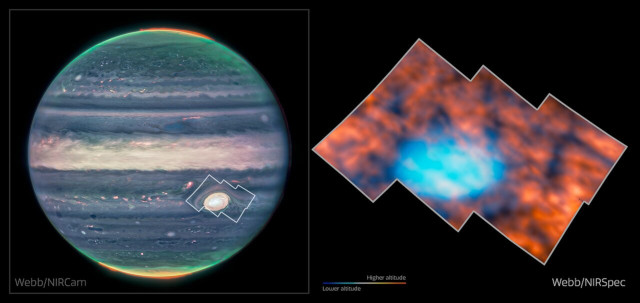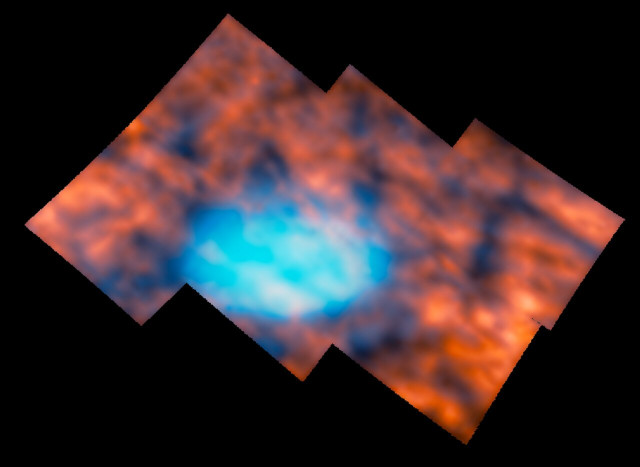
An article published in the journal “Nature Astronomy” reports the identification of structures in the planet Jupiter’s upper atmosphere above the Great Red Spot, the iconic storm larger than the Earth. A team of researchers led by Henrik Melin of the British University of Leicester used observations conducted with the James Webb Space Telescope to obtain new details of that area. The surprise came from the identification of intricate structures including dark arcs and bright spots in the observed area.
The top image (ESA/Webb, NASA & CSA, Jupiter ERS Team, J. Schmidt, H. Melin, M. Zamani (ESA/Webb)) shows on the left the planet Jupiter seen by the James Webb Space Telescope’s Near-Infrared Camera (NIRCam) instrument and on the right the Great Red Spot observed by the Near-InfraRed Spectrograph (NIRSpec) instrument.
Jupiter receives only 4% of the sunlight the Earth receives, meaning it reflects very little light that telescopes can pick up from Earth. This makes it difficult to obtain details of its upper atmosphere. This is a case in which the James Webb Space Telescope offers the power and infrared sensitivity necessary to obtain details that for once don’t belong to objects very distant in space and time but which are in the cosmic neighborhood.
The Great Red Spot was observed in July 2022 specifically with the Near-InfraRed Spectrograph (NIRSpec) instrument. Each image covered an area of around 300 square kilometers, meaning that six images were needed to cover the colossal storm.
The composite image of the area around the Great Red Spot shows the infrared light emitted by hydrogen molecules in Jupiter’s ionosphere. Those are molecules present about 300 kilometers above the clouds of the gigantic storm, where sunlight ionizes hydrogen and stimulates infrared emissions. In the images, the red colors show hydrogen emissions while the blue colors show infrared emissions at lower altitudes, including cloud-tops in the atmosphere and the Great Red Spot.
The researchers expected that area to have a homogeneous appearance due to the little sunlight that Jupiter receives. On the contrary, the details captured by the James Webb Space Telescope show a variety of intricate structures that include dark arcs and bright spots across the area. Henrik Melin commented that he and his colleagues thought that area was boring, but it turned out to be as interesting as the auroras in the polar areas if not more so.
The sunlight, albeit dim, that hits the Jovian atmosphere affects its upper layers but the researchers suggest that there may also be another mechanism that alters shapes and structures. One mechanism could be gravity waves (not to be confused with gravitational waves!), which are generated in the lower layers and then rise up to influence the structures in the upper layers.
Gravity waves are also sometimes observed in the Earth’s atmosphere but they are much weaker than those observed on Jupiter by the James Webb Space Telescope. The researchers hope they can conduct follow-up observations of those structures to understand how they move in the Jovian upper atmosphere, their changes over time, and improve our understanding of the energy balance in that region.
On April 14, 2023, ESA launched the Juice space probe, which will conduct detailed, close-up observations of Jupiter and some of its moons. The new information collected in this study on the Great Red Spot could be useful for the Juice mission as well in a synergy that can help to better understand the processes taking place in Jupiter’s atmosphere.


